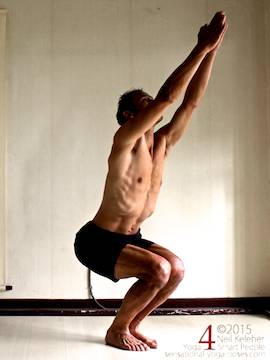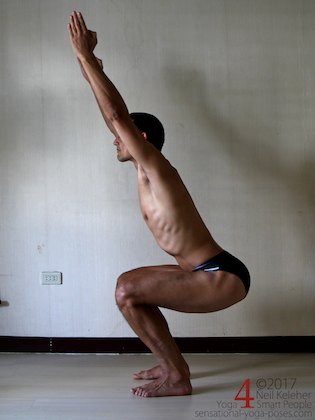Utkatasana
A step-by-step guide for body awareness
Utkatasana could be thought of as a squatting yoga pose. It's not a full squat but instead a half squat with the hips at knee height or slightly above knee height (so that the knees are bent roughly 90 degrees).
Utkatasana can be used to strengthen the thighs, particularly the quadriceps. Depending on how you do it, you could also use it to strengthen the gluteus maximus muscle.
One simple way to keep the knees a little bit safer in this pose is to shift your weight forwards so that your forefeet press down. In addition it can help to vary shin rotation relative to the foot so that the feet and ankles are active and comfortably positioned. With the feet active and the shins stabilized, muscles that work lower legs have a stable foundation from which to work on the knees and the hips.
Shifting your weight
A simple practice you could do before doing utkatasana is to practice shifting your weight forwards and back while standing. Shift weight to your forefeet, and then shift back to the backs of your heels. You can repeat this a few times and then work at shifting your weight somewhere between these two extremes.
When actually in utkatasana, the idea is to not aim for having your weight precisely centered front to back, but to vary it slightly so that your feet, ankles, knees and hips all feel comfortable.
Rotating your shins
After practicing shifting your weight, another exercise you can do with knees slightly bent and weight forwards on your forefeet is to rotate your shins outwards and inwards relative to your feet. Here you can notice the affect on your instep, how it causes your instep to lift and lower. You can also notice the effect on your forefeet, how it tends to vary the pressure between the outside edge of your forefeet and the inside edge.
In utkatasana, you can try this shin rotation with feet apart to begin with. Again have your weight comfortably forwards, but from there find the amount of rotation that feels comfortable on your feet, ankles, knees and hips.
With feet together, rotation the shins inwards can be difficult so you may choose to turn your feet outwards slightly or a lot to facilitate the degree of shin rotation that feels good on all of your leg joints.
Tilting your pelvis forwards and back
While standing with knees slightly bent, you can practice lifting and lower your sacrum so that your pelvis tilts forwards and back. Or focus on lowering and then lifting your pubic bone.
Another option is to focus on moving your sitting bones forwards and backwards so that your pelvis tilts backwards and forwards.
Trying the same actions in chair pose, a forward tilt will tend to maintain or accentuate the back bend of your lumbar spine while a backwards tilt will tend to flatten it.
If you strongly pull your sitting bones forwards, you may find your gluteus maximus activates. However, if you strongly reach them backwards, you may find that it also activates, but with a different sensation.
Bending your spine forwards and backwards
There may be little or no need to bend your spine forwards in chair pose, though you can try it to notice the effects for yourself.
While standing you can focus on tilting your pelvis forwards while actively bending yoru spine backwards. Notice the activation of your spinal erectors when doing so.
Then tilt your pelvis back. I'd suggest pulling your belly in to activate your transverse abdominis. And then from there, actively pull your front ribs down to activate your abs and to bend your spine forwards.
You can then repeat these actions in utkatasana.
Try tilting your pelvis back (you can pull your sitting bones forwards) and try to pull your front ribs down after pulling your lower belly in first. If this causes low back discomfort or pain, then leave this option out. Then try tilting your pelvis forwards. (Reach your sitting bones back!) And from there, actively bend your spine backwards.
Integrating what you've learned so far
Before adding the arms to utkatasana, you could review what you've learned so far. One option is to start with the pelvis and spine and from there adjust the shins and how you press down through your feet.
Tilting your pelvis back, you could pull in your lower belly and then pull your front ribs down. You may need to shift your weight forwards to get weight onto your forefeet. From there you can try internal and external shin rotation (or somewhere in-between) to find a position that feels good on your feet, ankles, knees and hips.
Tilting your pelvis forwards, you can back bend your spine and activate your spinal erectors. From there shift weight forwards or back as you need to. And then from there adjust shin rotation so that the joints of your legs from your feet to your hips are comfortable.
Lifting the arms for utkatasana
Ideally the hands are together above your head in utkatasana. But if you can't touch your palms, don't worry too much. Something you can practice to work towards it is to stand with your arms lifted and practice lifting your shoulder blades. (You'll be using the trapezius muscle.) From there straighten your elbows (make them feel strong) even if your arms move outwards as you do so.
Keeping your arms lifted, relax your shoulders and then lift them again. The try the same thing with a spinal back bend (spinal erectors active). I'd suggest work at gradually bringing your hands together while maintaining the back bend and also while keeping your shoulders maximally lifted and your elbows straight and strong.
Practice this while standing upright with knees straight or slightly bent and then from there with the knees bent in utkatasana.
One other thing that may help is to spread your shoulder blades either prior to lifting your arms or while they are lifted. The muscle you'll be trying to use in this case is the serratus anterior muscle.
 I'm looking up in this picture. You could also look forwards or even down.
I'm looking up in this picture. You could also look forwards or even down. Published: 2017 02 12
Updated: 2021 02 09




